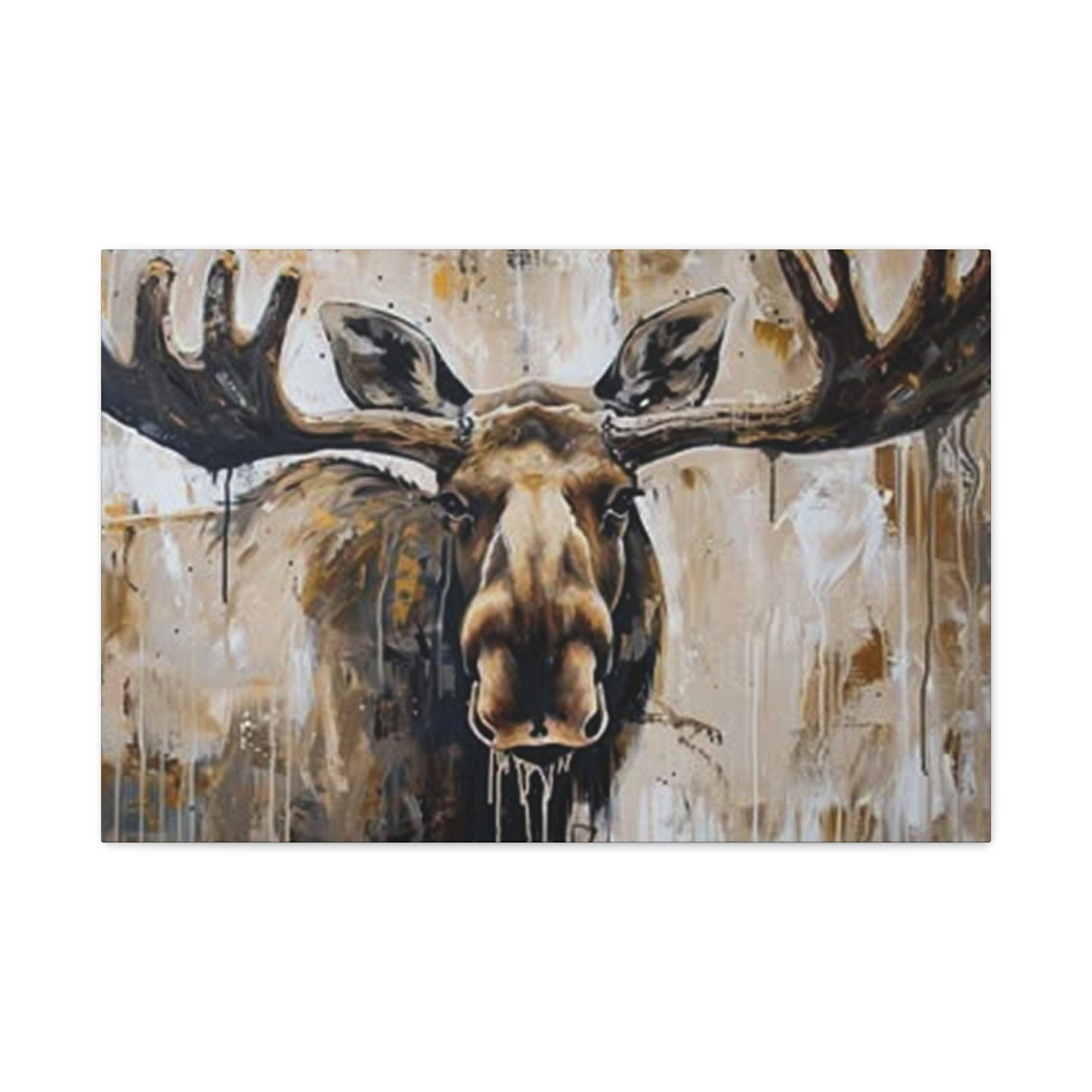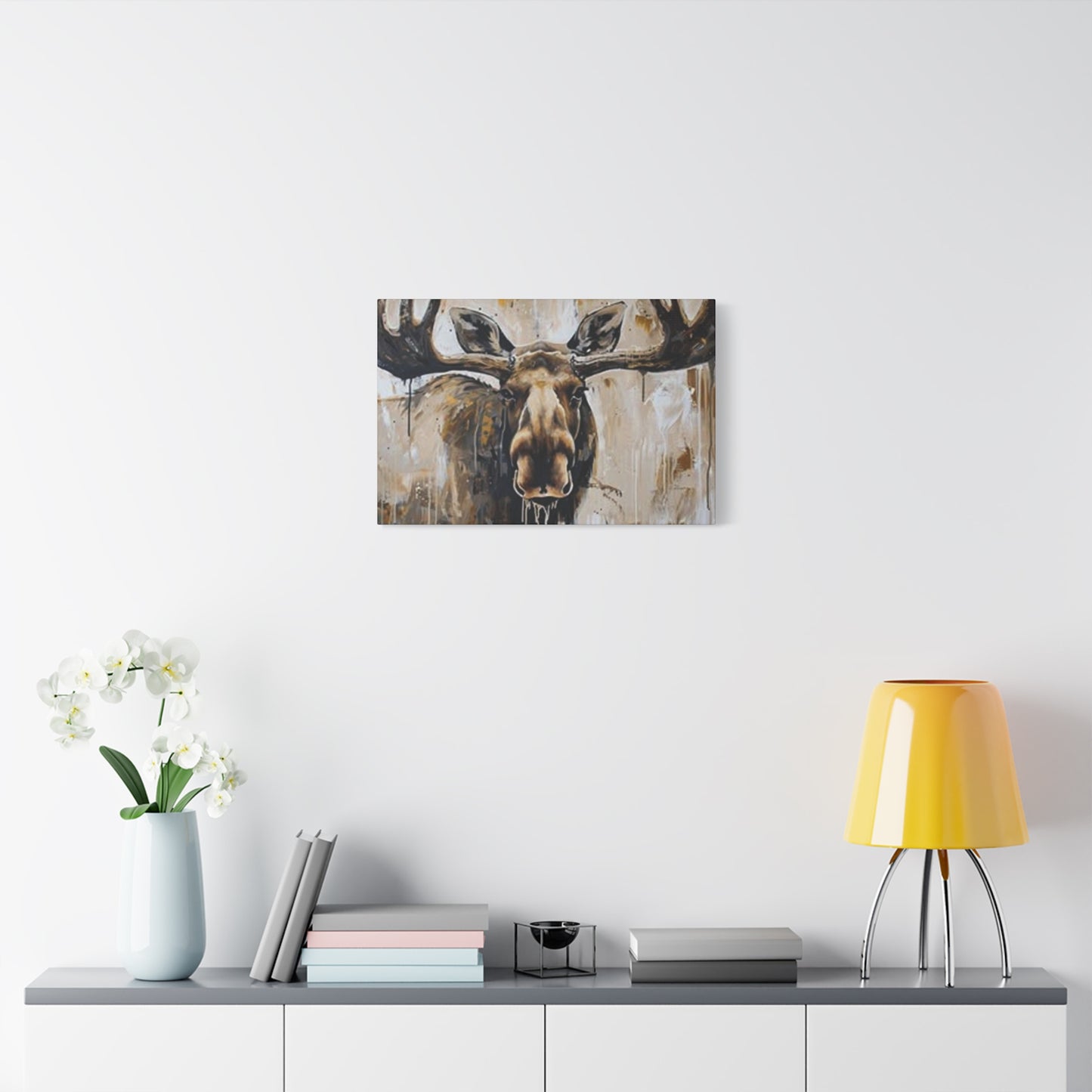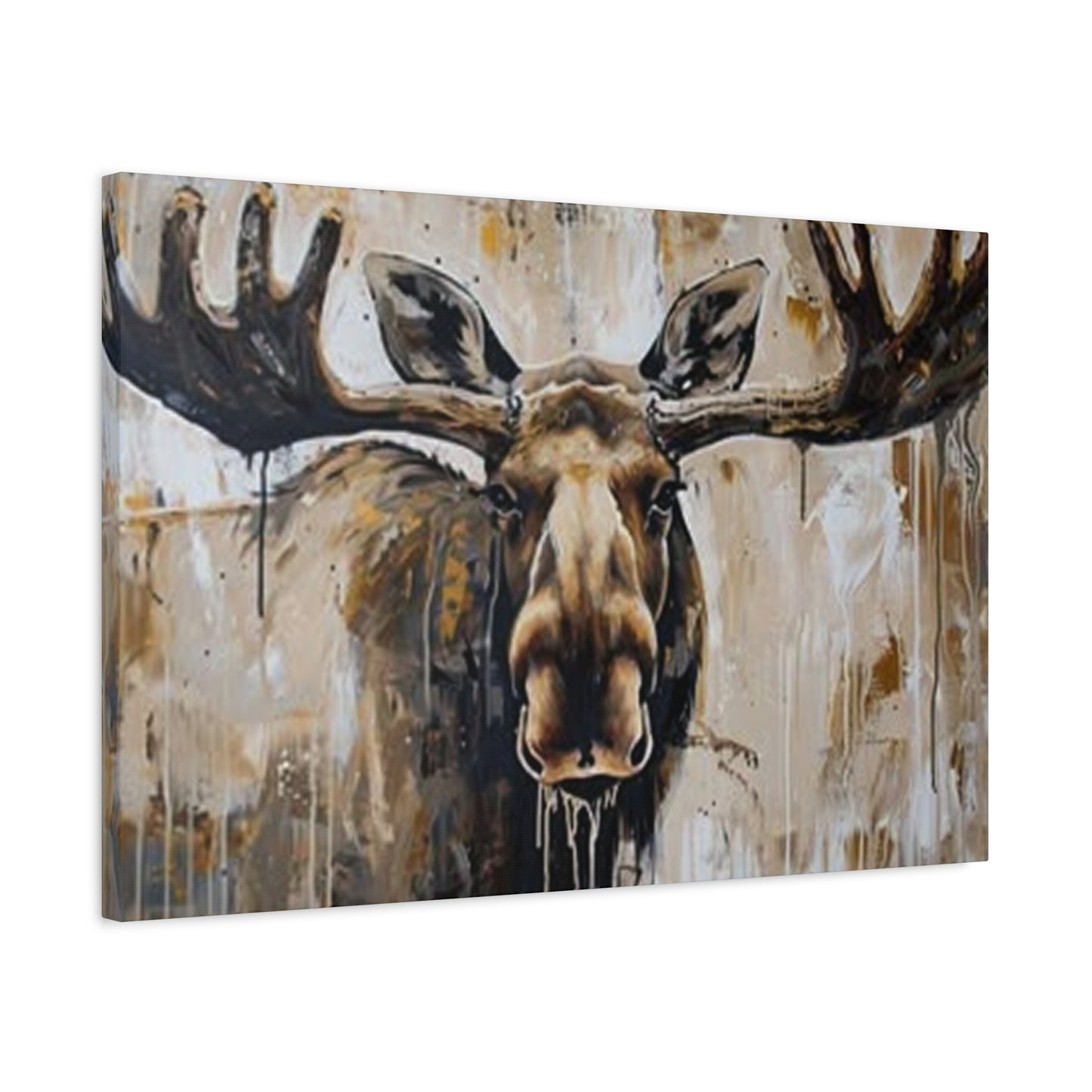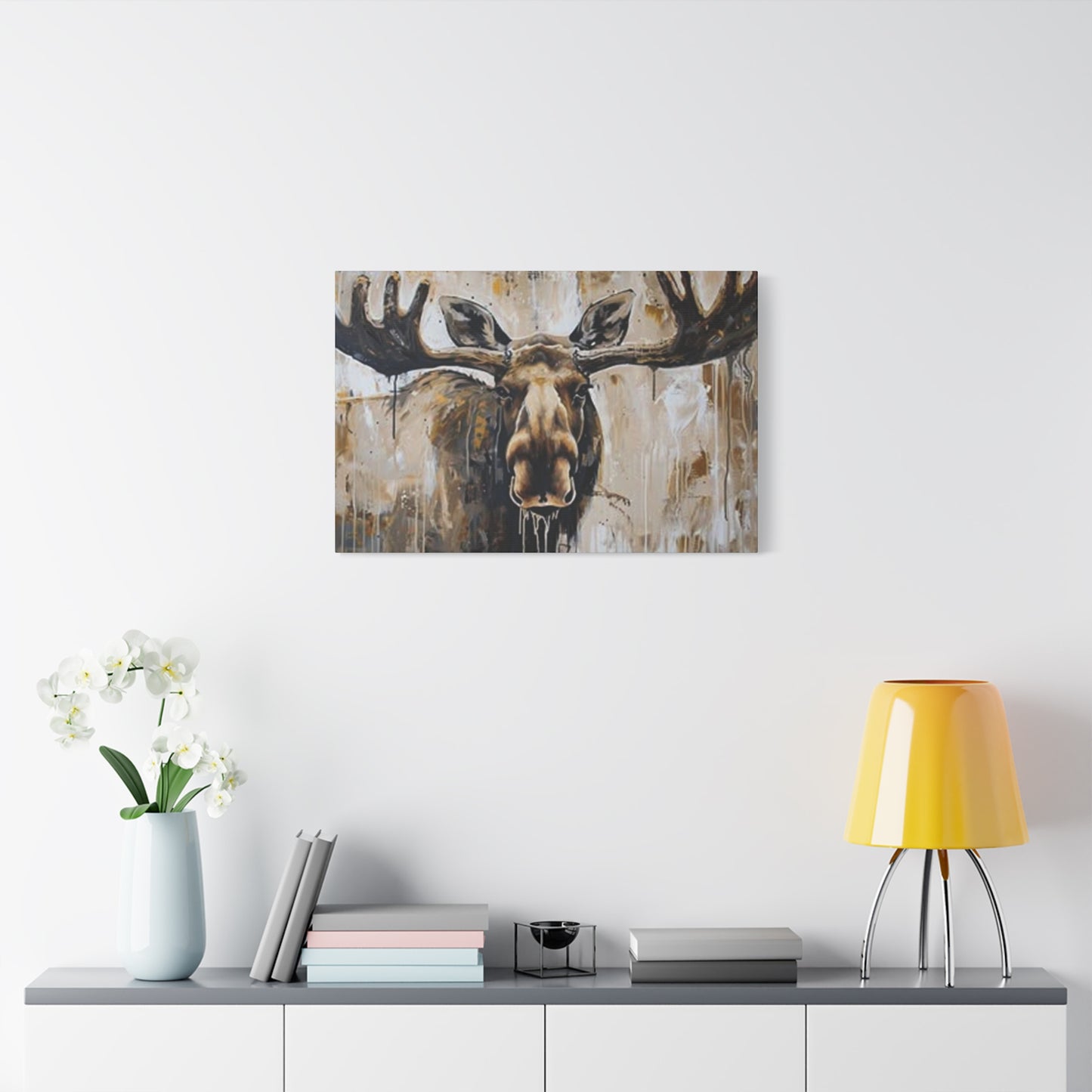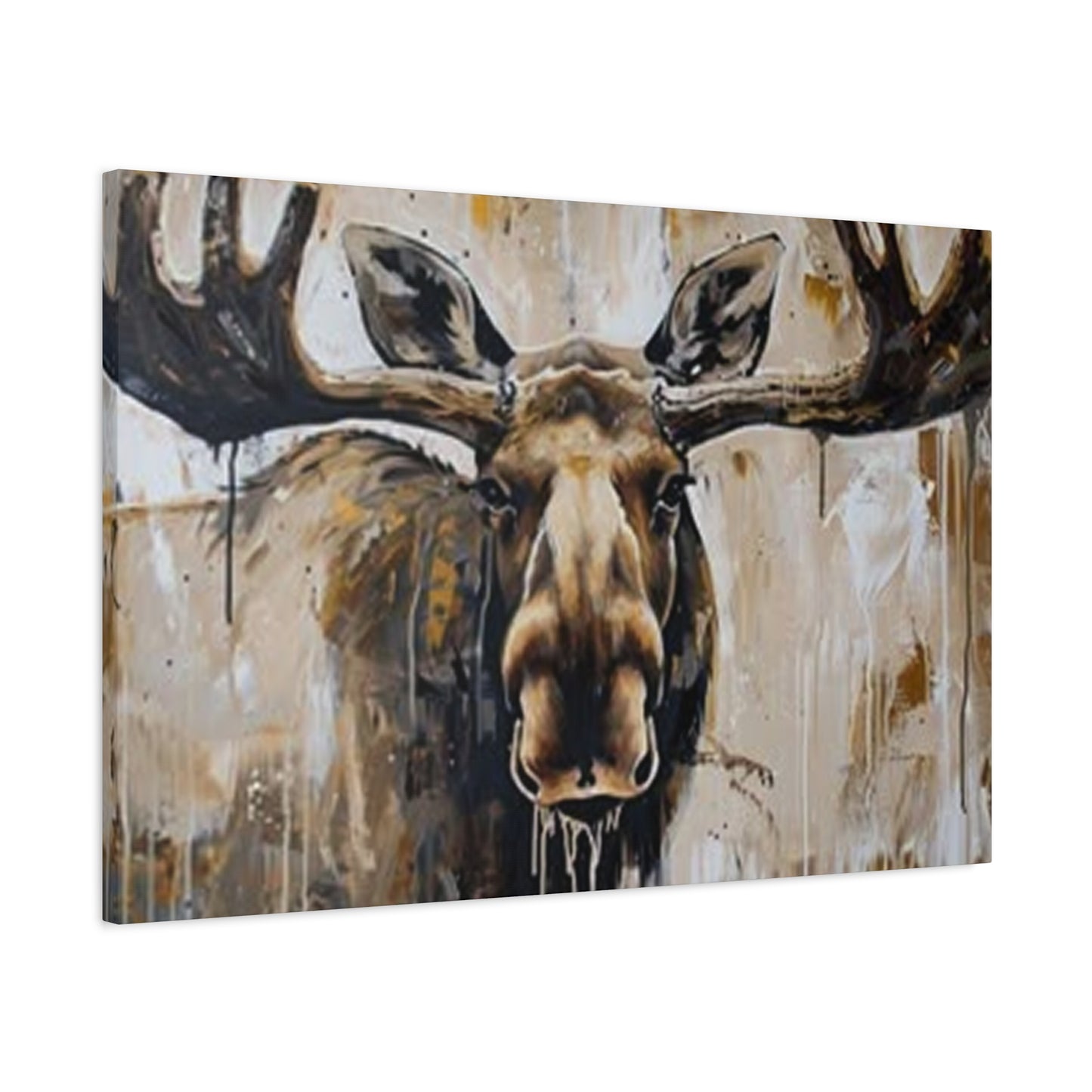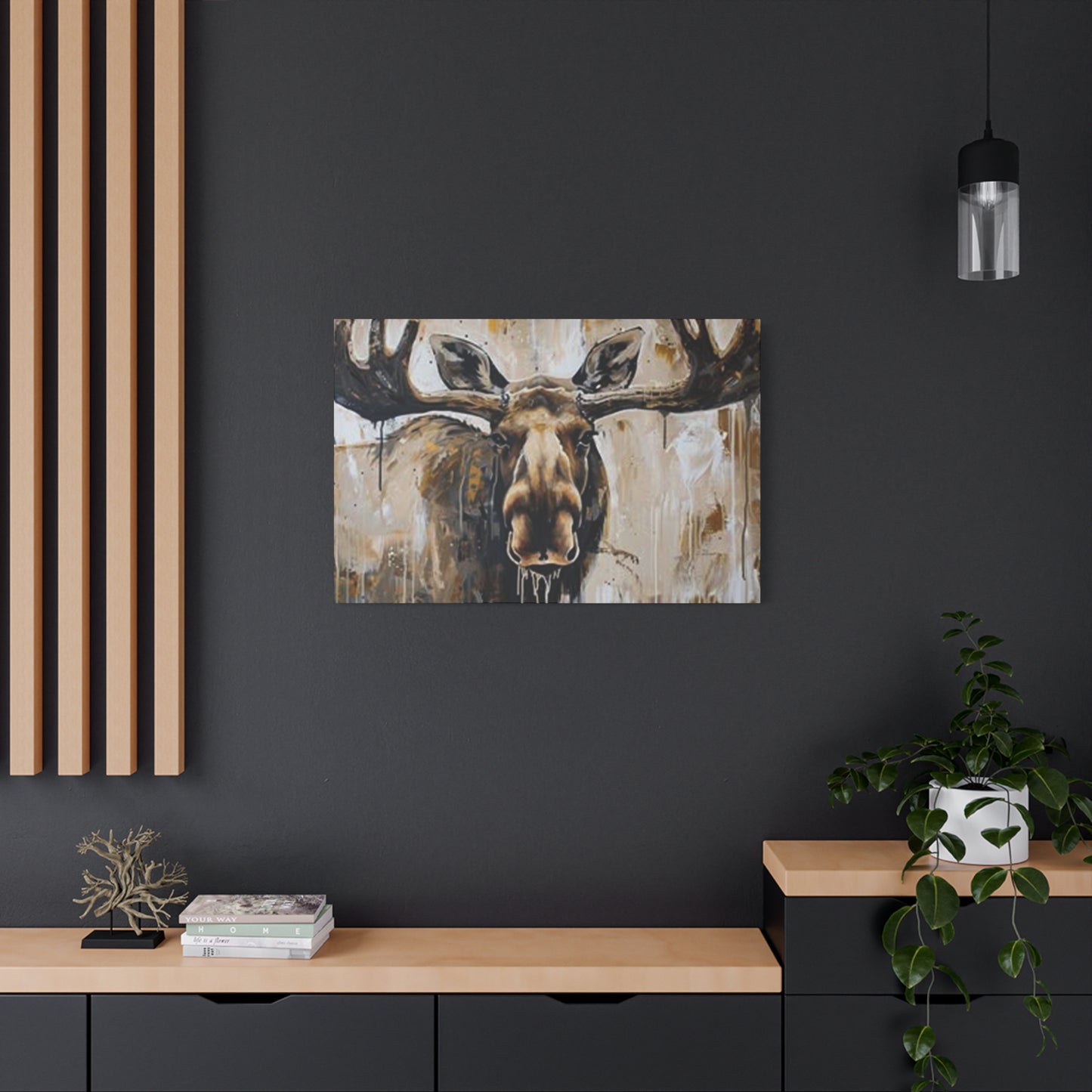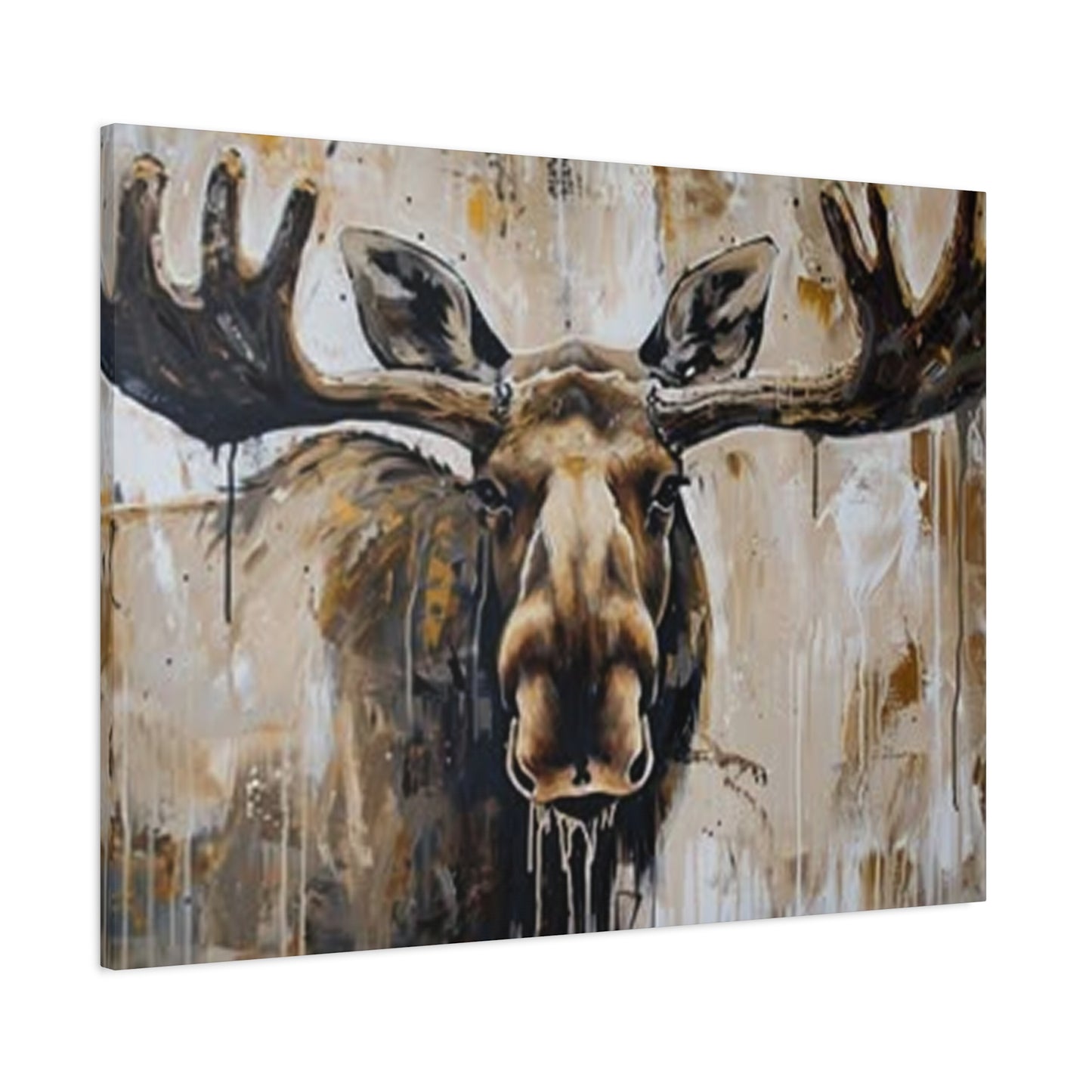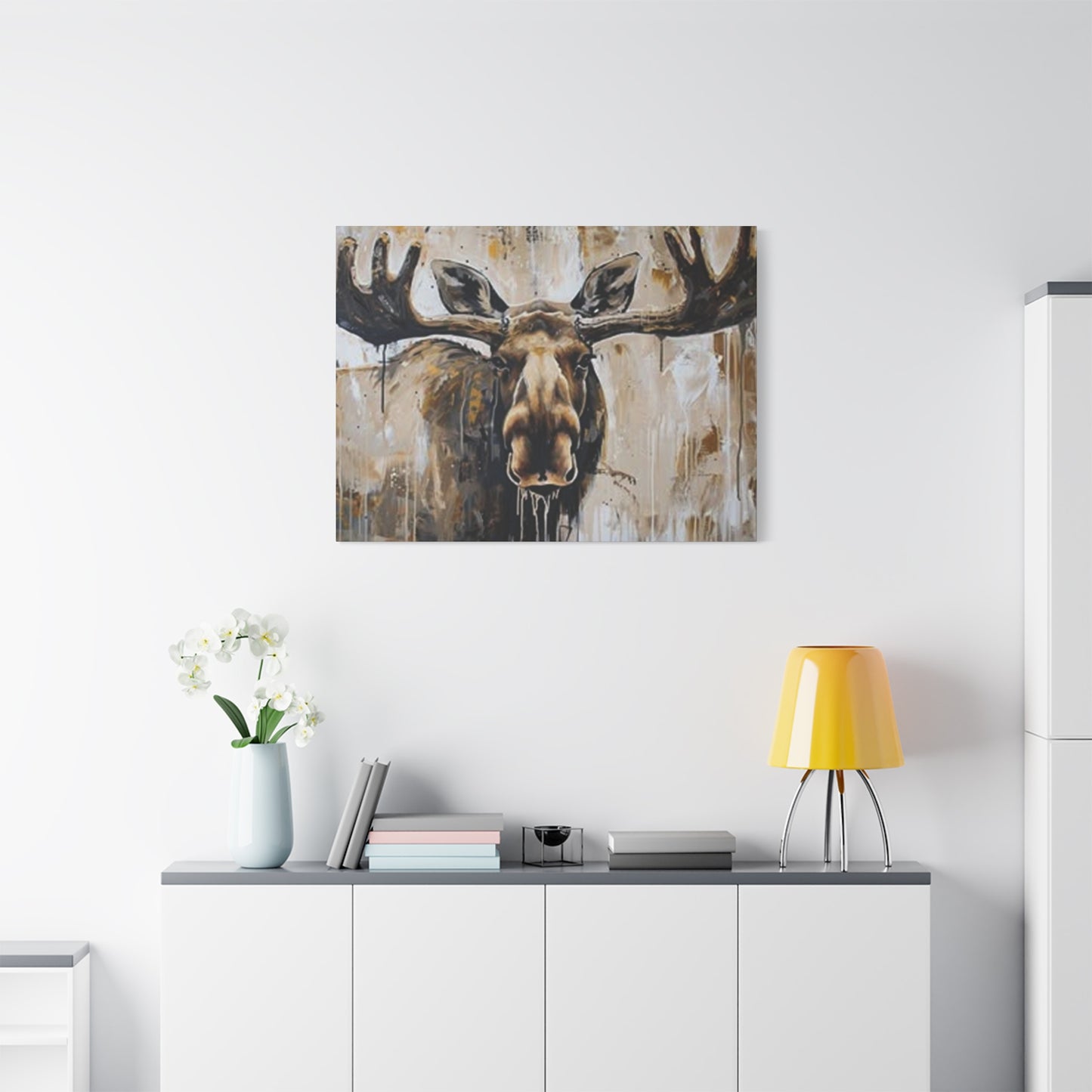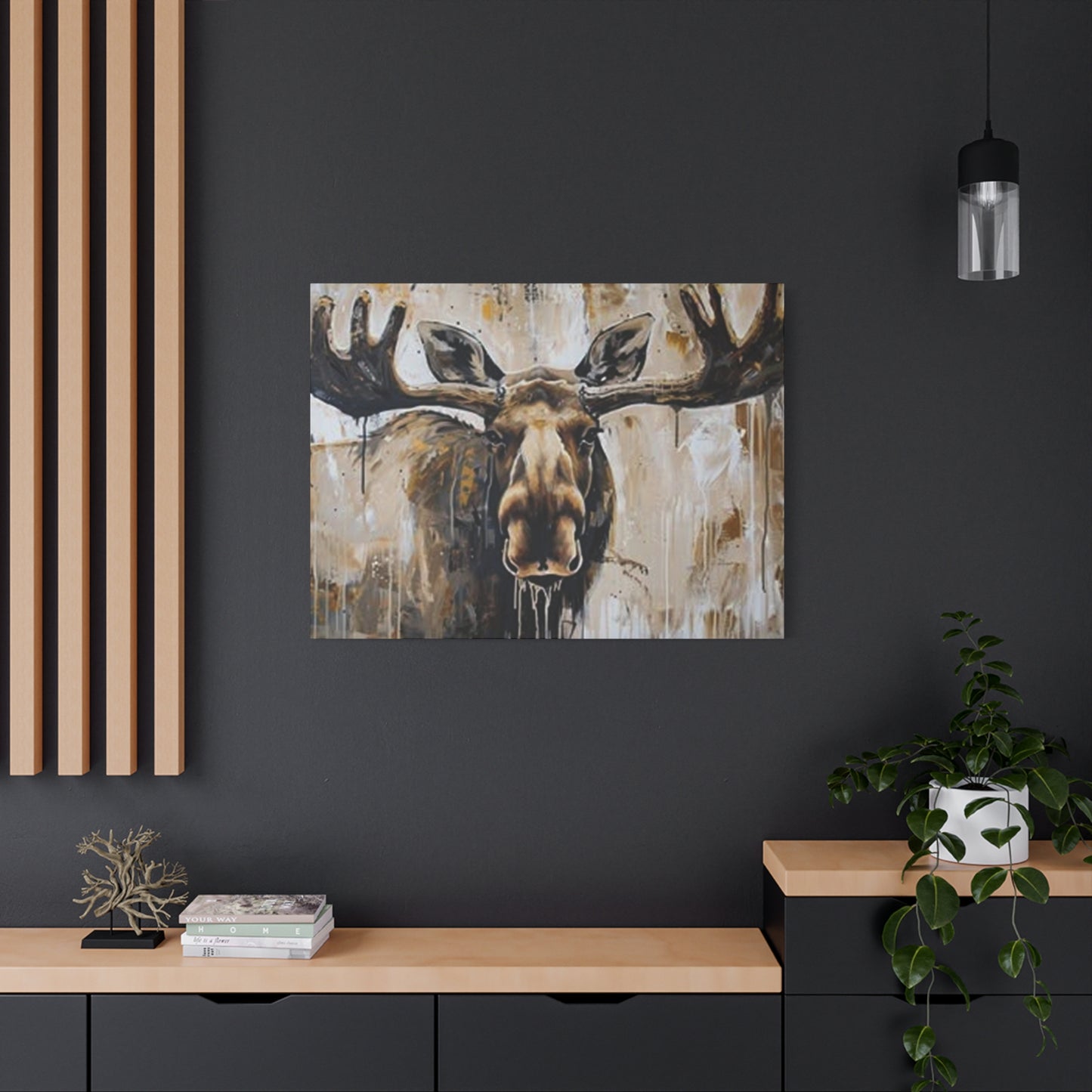How Scary Moose Wildlife Painting Wall Art Captures the Untamed Spirit of the Wild
The presence of wildlife imagery within interior spaces has evolved into a sophisticated form of artistic expression that bridges the gap between natural beauty and contemporary design. Among the most striking subjects in this genre stands the moose, a creature whose imposing stature and enigmatic presence have captivated artists and nature enthusiasts for generations. The integration of moose-themed artwork into residential and commercial environments represents more than mere decoration; it embodies a connection to wilderness, strength, and the untamed spirit of natural landscapes.
Wildlife paintings featuring moose have gained tremendous popularity as homeowners and designers seek to infuse spaces with character and meaning. These representations range from realistic portrayals that capture every detail of the animal's magnificent form to abstract interpretations that emphasize emotion and atmosphere. The versatility of moose imagery allows it to complement various interior design styles, from rustic cabin aesthetics to modern urban lofts, making it an increasingly sought-after choice for wall decoration.
Canvas prints have emerged as the preferred medium for bringing these powerful wildlife images into living spaces. The texture and depth that canvas provides enhance the visual impact of moose artwork, creating a gallery-quality presentation that elevates any room. Unlike traditional paper prints or posters, canvas offers durability and a professional finish that stands the test of time, making it an investment in both art and ambiance.
The Symbolic Significance of Moose in Artistic Expression
The moose carries profound symbolic weight across numerous cultures and artistic traditions. In Native American symbolism, this remarkable creature represents self-esteem, spontaneity, and the wisdom that comes from solitary contemplation. Artists who choose to depict moose in their work often tap into these deeper meanings, creating pieces that resonate on both aesthetic and spiritual levels.
Throughout history, the moose has been portrayed as a symbol of strength without aggression, confidence without arrogance. Its ability to thrive in harsh environments while maintaining grace and dignity makes it an emblem of resilience. When incorporated into home decor, moose imagery serves as a daily reminder of these qualities, inspiring occupants to embrace their own inner strength and navigate life's challenges with similar poise.
The solitary nature of moose also appeals to those who value independence and self-reliance. Unlike many herd animals, moose prefer to spend much of their time alone, emerging from forest depths to graze in meadows and wetlands. This characteristic has made moose artwork particularly popular among individuals who appreciate solitude and find strength in their own company. The image of a lone moose against a wilderness backdrop can evoke feelings of peaceful contemplation and connection to nature's rhythms.
In contemporary artistic interpretations, moose have come to represent the intersection of power and gentleness. Despite their impressive size and formidable antlers, these animals generally avoid confrontation and move through their habitats with surprising delicacy. Artists capture this duality through various techniques, using color, composition, and brushwork to convey the complex character of these magnificent creatures.
Exploring Different Artistic Styles in Moose Wildlife Paintings
The world of moose artwork encompasses an extraordinary range of artistic approaches, each offering unique visual experiences and emotional impacts. Realistic paintings strive to capture every detail of the moose's physical characteristics, from the texture of their coarse fur to the intricate branching of their antlers. These works often require hundreds of hours of meticulous observation and technical skill, resulting in images so lifelike they seem to breathe.
Impressionistic interpretations of moose take a different approach, focusing on capturing the essence and atmosphere of the subject rather than precise anatomical accuracy. These paintings use bold brushstrokes and vibrant color palettes to evoke the feeling of encountering a moose in its natural habitat. The interplay of light and shadow becomes paramount, with artists emphasizing the emotional response to the subject over documentary precision.
Abstract moose artwork pushes boundaries even further, reducing the animal to its most fundamental shapes and forms. These pieces might represent a moose through geometric patterns, color fields, or expressive marks that suggest rather than depict. Abstract interpretations allow viewers to engage with the artwork on a more intuitive level, finding personal meaning in the interplay of visual elements.
Watercolor moose paintings offer delicate, ethereal qualities that contrast beautifully with the animal's substantial physical presence. The transparent layers of watercolor create luminous effects that can suggest misty mountain mornings or the dappled light filtering through forest canopies. This medium excels at capturing the fleeting qualities of natural light and atmosphere that surround moose in their native environments.
Oil painting remains a classic choice for moose artwork, providing rich textures and depth that enhance the three-dimensional quality of the subject. The slow-drying nature of oil paints allows artists to blend colors seamlessly and build up layers that create remarkable realism or expressive intensity. Oil paintings on canvas develop a patina over time that adds to their character and value.
The Natural Habitat: Setting the Scene in Moose Artwork
The environments depicted in moose paintings play crucial roles in establishing mood and narrative. Northern forests provide dramatic backdrops with their dense stands of spruce, pine, and fir. These evergreen settings create year-round visual interest, with the dark foliage offering striking contrast against the lighter tones of moose fur or winter snow. Artists often use these forest scenes to evoke feelings of mystery and ancient wilderness.
Mountain landscapes provide another popular setting for moose imagery. Alpine meadows, rocky outcroppings, and distant peaks create a sense of grandeur that complements the moose's imposing stature. These compositions often emphasize the relationship between the animal and the vast, rugged terrain it inhabits, highlighting themes of endurance and adaptation to challenging environments.
Wetland scenes showcase moose in their element, as these animals spend considerable time in marshes, ponds, and lake edges feeding on aquatic vegetation. Artwork featuring moose in water settings captures moments of vulnerability and tranquility, with the animal's massive form reflected in still waters. These compositions often incorporate elements like lily pads, reeds, and waterfowl to create rich, layered ecosystems.
Seasonal variations provide endless inspiration for moose artwork. Autumn scenes burst with golden aspens and crimson maples, creating warm color palettes that evoke harvest abundance. Winter compositions emphasize stark beauty, with moose standing out against pristine snow, their breath visible in cold air. Spring and summer settings celebrate renewal and vitality, showing moose among fresh greenery and wildflowers.
Weather conditions add drama and atmosphere to moose paintings. Misty mornings create soft, dreamlike qualities as the animal emerges from fog-shrouded forests. Storm scenes demonstrate the moose's resilience against driving rain or swirling snow. Sunrise and sunset lighting bathes subjects in warm, golden tones that enhance emotional impact and visual appeal.
Canvas Printing Technology and Quality Considerations
Modern canvas printing technology has revolutionized access to high-quality wildlife artwork. Giclée printing, derived from the French word meaning "to spray," uses specialized inkjet printers that apply microscopic droplets of archival-quality ink to canvas surfaces. This process achieves color accuracy and detail resolution that rivals traditional painting techniques, making museum-quality reproductions available to wider audiences.
The canvas material itself significantly impacts the final appearance and longevity of prints. Premium cotton canvas offers superior texture and archival properties compared to synthetic alternatives. The weave density of the canvas affects how well it accepts ink and maintains structural integrity when stretched. Heavier canvas weights, typically measured in ounces per square yard, provide more substantial feel and greater resistance to warping or sagging over time.
Ink quality determines how colors appear initially and how they maintain vibrancy over years of display. Pigment-based inks offer superior fade resistance compared to dye-based alternatives, with some formulations guaranteed to maintain color fidelity for seventy-five years or more under proper display conditions. The chemical composition of these inks allows them to bond with canvas fibers rather than simply coating the surface, enhancing durability.
Protective coatings applied after printing serve multiple functions. UV-resistant varnishes shield artwork from the damaging effects of sunlight, which can cause fading and discoloration over time. These coatings also provide moisture resistance, protecting against humidity and accidental splashes. Some treatments offer additional benefits like scratch resistance and easier cleaning, extending the practical lifespan of canvas prints.
Color calibration throughout the printing process ensures that the final product accurately represents the artist's original vision. Professional printers use spectrophotometers and color management systems to match digital files to physical output. This technical precision becomes especially important when reproducing paintings with subtle color gradations or specific atmospheric effects that define the mood of moose artwork.
Framing and Presentation Options for Canvas Artwork
Gallery wrap stretching has become the standard presentation method for canvas prints, creating a clean, contemporary look that requires no additional framing. In this technique, the canvas extends around the edges of wooden stretcher bars, with the image either continuing around the sides or featuring mirrored or solid color edges. The result is a finished piece ready to hang immediately upon receipt.
The depth of stretcher bars influences the visual impact and shadow effects of canvas artwork. Standard depths of three-quarters of an inch create subtle dimensionality, while deeper options of one and a half inches or more produce dramatic shadow lines that enhance the perception of the artwork as a substantial object rather than a flat surface. Deeper stretches work particularly well for larger pieces or in spaces where the artwork is viewed from multiple angles.
Traditional frame options remain popular for those seeking more formal presentations or coordination with existing decor. Wood frames in natural finishes complement the organic subject matter of moose artwork, with options ranging from rustic barnwood to polished walnut. Metal frames offer contemporary alternatives that work well in modern interiors, with finishes like brushed aluminum or matte black providing sleek borders without overwhelming the artwork.
Float mounting creates sophisticated presentations where canvas appears to hover within the frame, separated by a small gap that emphasizes the artwork as an object of contemplation. This technique adds depth and draws attention to the canvas texture while providing the protective and decorative benefits of framing. Float mounting works exceptionally well for moose paintings where the subject matter benefits from this enhanced sense of presence.
Triptych and multi-panel configurations allow single images to span multiple canvases, creating dramatic installations that command attention on large walls. These arrangements can present a panoramic view of a moose in its habitat or create abstract compositions where the divisions between panels become part of the artistic statement. The spacing between panels contributes to the overall effect, with wider gaps creating more distinct separation and narrower spacing maintaining visual continuity.
Spatial Considerations for Wall Art
Determining the appropriate size for moose artwork requires careful consideration of the display space and viewing distances. The general principle suggests that artwork should occupy roughly two-thirds to three-quarters of the available wall space above furniture pieces like sofas or console tables. This proportion creates visual balance without overwhelming the space or appearing undersized and insignificant.
Ceiling height influences ideal artwork dimensions, with taller rooms accommodating larger pieces more gracefully. In spaces with eight-foot ceilings, artwork heights of twenty-four to thirty-six inches typically work well, while rooms with ten-foot or higher ceilings can support pieces reaching forty-eight inches or more. The vertical dimension becomes particularly important for portrait-oriented moose paintings that emphasize the animal's height and antler spread.
Viewing distance affects how artwork is experienced and appreciated. Close viewing distances, such as in hallways or small rooms, favor smaller to medium-sized pieces with detailed elements that reward closer inspection. Larger rooms where artwork is viewed from greater distances benefit from bigger pieces with bolder compositions that maintain visual impact across space. Moose paintings with dramatic, simplified forms work particularly well for these distant viewing scenarios.
Wall color and lighting conditions interact with artwork size to influence overall effect. Lighter walls tend to make artwork appear slightly smaller while darker walls can make pieces seem larger and more prominent. Natural light from windows creates variable viewing conditions throughout the day, while dedicated artwork lighting ensures consistent presentation regardless of external lighting. These factors should inform size selection to achieve desired impact.
Multiple piece arrangements require additional planning regarding individual canvas sizes and overall configuration dimensions. Gallery walls featuring several moose paintings of varying sizes create dynamic, personalized displays. Symmetrical arrangements with identically sized pieces offer formal elegance, while asymmetrical groupings with diverse dimensions provide contemporary visual interest. Template tools and planning software help visualize these arrangements before committing to wall installation.
Moose Behavior and Biology Informing Artistic Accuracy
Understanding moose biology enhances appreciation for accurately rendered artwork and helps identify pieces that capture authentic characteristics. Adult male moose, called bulls, stand six to seven feet tall at the shoulder and weigh between eight hundred and fifteen hundred pounds, making them the largest members of the deer family. Their massive size should be evident in artwork through proportion and presence, distinguishing them from deer, elk, or caribou.
The distinctive antlers of bull moose rank among nature's most impressive structures, growing to spans exceeding six feet and weights surpassing sixty pounds. These antlers develop in a single growing season, covered initially in nutrient-rich velvet that sheds in autumn as the bone hardens. Accurate artwork depicts antler architecture appropriate to the season shown, with velvet covering in summer scenes and bare, hardened antlers in fall and winter compositions.
Female moose, called cows, lack antlers but possess their own elegant beauty. Artwork featuring cows often emphasizes their graceful proportions and alert expressions. Cows with calves provide touching family scenes popular in wildlife art, though accurate depictions show the protective vigilance characteristic of moose mothers. Calves stay with their mothers for about one year, providing seasonal context clues in artwork.
Moose anatomy includes several distinctive features that skilled artists capture precisely. The pendulous dewlap or bell hanging from the throat remains a subject of biological curiosity, and its presence or absence in artwork affects authenticity. The long, powerful legs enable moose to navigate deep snow and wade into water, and their proportions relative to body size should appear correct. The overhanging upper lip aids in grasping branches and vegetation, contributing to the moose's characteristic profile.
Behavioral authenticity adds credibility and interest to moose paintings. These animals are most active during dawn and dusk, and lighting conditions in artwork can reflect these activity patterns. Moose feed primarily on woody plants, aquatic vegetation, and fresh growth, so depictions of feeding behavior should show appropriate food sources. The solitary nature of moose, particularly outside breeding season, makes lone animal compositions biologically accurate, though small groups occasionally appear in areas with excellent habitat.
Regional Variations Among Moose Populations
Geographic differences among moose subspecies provide fascinating details that some wildlife artists incorporate into their work. Alaskan moose represent the largest subspecies, with bulls regularly exceeding fourteen hundred pounds. Artwork depicting these giants captures their impressive bulk and the vast subarctic landscapes they inhabit. The Alaskan tundra and boreal forest backgrounds create distinct visual contexts.
Eastern moose, found throughout northeastern United States and eastern Canada, occupy more forested habitats than their western cousins. These animals have adapted to regions with more human activity, and artwork occasionally depicts them in proximity to rural development. The mixed forests of maple, birch, and conifer typical of this range provide rich, varied backgrounds with seasonal color changes that inspire artistic interpretation.
Shiras moose, the smallest subspecies, inhabit the Rocky Mountain region of the United States. Despite being smaller than other subspecies, they remain impressively large animals. Artwork featuring Shiras moose often emphasizes mountain landscapes, with dramatic peaks and alpine meadows creating compositions that celebrate western wilderness. The elevation gradients of their habitat allow for diverse environmental backdrops within relatively small geographic areas.
Northwestern moose occupy vast territories across western Canada and Alaska. These animals contend with extreme climate variations and diverse habitats ranging from coastal rainforests to interior boreal forests. Artwork representing this subspecies might depict them against backdrops of towering spruce, alongside salmon streams, or navigating snowy mountain passes. The raw wilderness character of these regions inspires particularly dramatic artistic interpretations.
European moose, called elk in Europe, inhabit Scandinavia and parts of Russia. While not commonly featured in North American wildlife art markets, these animals appear in European artistic traditions. Cultural differences in how moose are perceived and represented provide interesting comparative perspectives. European artwork might emphasize different aspects of moose character or show them in landscapes distinctly different from North American wilderness scenes.
Practical Benefits of Canvas Prints Versus Other Mediums
Canvas prints offer numerous advantages over alternative wall art formats. The texture inherent to canvas surfaces creates visual interest and depth absent from smooth paper prints or photographs. This texture catches light at different angles throughout the day, creating subtle variations in how the artwork appears. The slight three-dimensionality adds life to images, making them feel more substantial and gallery-worthy.
Durability stands as a major benefit of canvas over paper-based alternatives. Canvas resists tearing and damage far better than paper, and the lack of glass covering means no risk of breakage during hanging or cleaning. This makes canvas prints particularly suitable for homes with children or pets where accidents might occur. The robust nature of canvas also simplifies the hanging process, as the wrapped edges provide surfaces that mounting hardware can grip securely.
The lightweight nature of canvas prints compared to framed glass art makes them easier to transport and hang. A large canvas piece weighs significantly less than an equivalently sized framed print under glass, reducing shipping costs and simplifying installation. Single individuals can typically hang even large canvas pieces without assistance, whereas framed glass art often requires two people for safe handling.
Maintenance requirements for canvas prints remain minimal. The absence of glass eliminates glare issues that plague traditionally framed art, ensuring visibility from all viewing angles regardless of lighting conditions. Cleaning requires only occasional light dusting with soft cloths, and the protective coatings applied to quality canvas prints resist dirt accumulation. This practical simplicity appeals to busy households where complicated maintenance routines prove impractical.
Cost considerations favor canvas prints when comparing them to original paintings or limited edition traditional prints. While not as inexpensive as basic posters, canvas prints provide significantly elevated aesthetic quality at accessible price points. This democratization of art allows more people to enjoy gallery-quality wildlife imagery in their homes, building personal art collections that reflect individual tastes without requiring substantial financial investment.
Creating Gallery Walls with Wildlife Themes
Curating cohesive gallery walls featuring moose and complementary wildlife imagery allows for creative expression while maintaining visual harmony. Starting with a focal piece, typically the largest or most visually striking moose painting, provides an anchor around which additional pieces can be arranged. This dominant artwork establishes the theme and style that other selections should complement rather than compete with.
Mixing sizes creates visual interest and prevents monotony in multi-piece displays. Combining large statement pieces with smaller supporting artworks guides the eye through the composition while maintaining overall balance. The largest pieces typically occupy center positions or align with eye level, while smaller works fill surrounding spaces. This varied scale mimics how elements appear in nature, creating organic rather than rigid arrangements.
Maintaining consistent color palettes across gallery wall pieces ensures cohesion despite subject matter variations. If the central moose painting features autumn colors, surrounding pieces might include other wildlife in similar seasonal settings or abstract works incorporating comparable warm tones. This color unity ties diverse elements together, creating sophisticated displays that feel intentional rather than randomly assembled.
Frame consistency contributes to gallery wall success when pieces include framing. Matching frame styles, colors, and widths create unified appearances even when artwork varies. Alternatively, consistent matting colors around diverse frames can provide cohesion. For unframed canvas wraps, maintaining similar edge treatments or stretcher bar depths helps create visual relationships among separate pieces.
Spacing between pieces affects overall impact, with closer arrangements creating more unified single compositions and wider spacing emphasizing individual pieces. Templates made from paper or digital planning tools help visualize arrangements before committing to wall installation. These planning stages allow experimentation with different configurations, ensuring optimal results before creating nail holes or installing hanging hardware.
Seasonal Rotation and Refresh Strategies
Rotating artwork seasonally keeps living spaces feeling fresh and responsive to changing times of year. Moose paintings depicting winter scenes naturally suit colder months, creating visual harmony between indoor and outdoor environments. The sight of snow-covered moose in December reinforces seasonal atmosphere and connects indoor comfort with outdoor winter beauty.
Spring rotation might replace winter moose scenes with images showing the animals during calving season or in environments showing renewal and fresh growth. These lighter, more hopeful compositions align with spring's rejuvenating energy. The transition from winter to spring artwork can mirror natural cycles, creating homes that feel attuned to earth's rhythms.
Summer brings opportunities for moose artwork featuring lush green forests, wetland feeding scenes, or animals enjoying cool water. These images evoke summer abundance and outdoor recreation, aligning with seasons when people spend more time appreciating nature. The vibrant greens and blues of summer moose paintings brighten interiors and celebrate the growing season's vitality.
Autumn presents peak opportunities for moose artwork, as this season features both spectacular foliage and the moose rutting season. Paintings showing bull moose with magnificent autumn antlers amid golden aspens or crimson maples create warm, inviting atmospheres perfect for cozy autumn evenings. The rich colors of autumn moose art complement seasonal decorating with pumpkins, gourds, and harvest themes.
Storage solutions for off-season artwork protect pieces while keeping them accessible for regular rotation. Canvas wraps store efficiently in closets or under beds when wrapped in protective materials. Some collectors dedicate specific storage areas to their artwork collections, organizing pieces by season or theme for easy retrieval. Proper storage prevents damage and extends the lifespan of all pieces in a rotating collection.
Lighting Techniques to Enhance Moose Artwork
Proper illumination dramatically affects how artwork appears and the atmosphere it creates. Track lighting systems offer flexibility, allowing adjustable spotlights to focus precisely on artwork while leaving surrounding walls in relative shadow. This technique creates dramatic presentations that draw attention to featured pieces, ideal for highlighting impressive moose paintings in living rooms or galleries.
Picture lights mounted directly above or below artwork provide focused illumination that eliminates glare while evenly lighting the entire piece. LED picture lights have become popular due to their energy efficiency, cool operation, and long lifespan. These dedicated fixtures can be hardwired or battery-operated, with wireless options simplifying installation without requiring electrical work.
Natural lighting considerations influence both artwork placement and preservation. While daylight beautifully illuminates moose paintings, prolonged direct sunlight exposure causes fading over time despite protective coatings. Placing artwork on walls perpendicular to windows allows natural light to illuminate pieces without direct sun exposure. UV-filtering window treatments provide additional protection while maintaining light quality.
Ambient room lighting creates different effects throughout the day. Warm-toned evening lighting from lamps and overhead fixtures adds golden casts to artwork, potentially enhancing warm color palettes or creating interesting contrasts with cool-toned pieces. Adjustable lighting systems with dimming capabilities allow customization of illumination levels to suit different times and activities.
Strategic lighting creates depth and dimension that enhance the three-dimensional qualities of canvas prints. Angling light across the canvas surface emphasizes texture and creates subtle shadows that bring artwork to life. Experimenting with lighting positions reveals how dramatically illumination affects artwork appearance, allowing fine-tuning to achieve optimal presentation.
Investment Value and Collectibility Considerations
Limited edition prints hold greater investment potential than open edition reproductions. When artists or publishers restrict production to specific numbers of prints, scarcity increases, potentially building future value. Numbered and signed prints command premium prices in secondary markets, particularly as edition numbers diminish through sales. Collectors interested in potential appreciation should seek these limited offerings.
Artist reputation significantly influences artwork investment value. Established wildlife artists with strong collector followings and exhibition records create works more likely to appreciate over time. Researching artists' backgrounds, awards, and market performance helps identify creators whose work shows investment promise. Emerging artists sometimes offer opportunities to acquire quality work at lower initial prices before wider recognition drives prices higher.
Provenance documentation establishes artwork authenticity and ownership history, crucial factors affecting value. Certificates of authenticity, purchase receipts, and edition information should be preserved carefully throughout ownership. This documentation becomes essential if pieces are later sold or appraised, as it verifies legitimate origins and protects against fraudulent reproductions.
Condition maintenance preserves both aesthetic appeal and market value. Following recommended display and care guidelines prevents deterioration that diminishes artwork worth. Avoiding direct sunlight exposure, maintaining stable temperature and humidity, and using appropriate cleaning methods keep pieces in excellent condition. Professional conservation services can address any damage that does occur, though prevention remains preferable and more cost-effective.
Market trends in wildlife art fluctuate with changing tastes and economic conditions. Periods of strong interest in rustic or nature-inspired design drive demand for moose and similar wildlife subjects. Understanding these trends helps collectors time purchases and sales advantageously, though artwork should primarily be acquired based on personal enjoyment rather than purely speculative investment motives.
Customization and Personalization Options
Custom canvas prints transform personal moose photographs into professional artwork. Many printing services accept customer-provided images, applying the same quality standards used for professional artwork reproductions. This option allows hunters, wildlife photographers, and nature enthusiasts to immortalize their own encounters with moose, creating deeply meaningful pieces with personal stories and memories attached.
Size customization ensures artwork fits specific spaces perfectly. While standard sizes work for many applications, custom dimensions address unusual wall spaces or design visions. Some areas like stairwells, above doorways, or between windows require non-standard proportions, and custom sizing eliminates the compromise of selecting from limited preset options.
Text additions personalize artwork with names, dates, locations, or meaningful quotes. A moose painting might include the coordinates of a special encounter location, a family name establishing the piece as heirloom art, or an inspirational phrase complementing the imagery. These additions transform generic artwork into unique, personalized pieces that tell specific stories.
Color adjustments and filters modify existing artwork to better suit interior design requirements. Converting color images to sepia tones or black-and-white creates different aesthetic effects. Adjusting color saturation, brightness, or contrast customizes pieces to complement room color schemes. These modifications allow artwork to be tailored precisely to design visions while maintaining the essential composition and subject matter.
Splitting single images across multiple canvases creates custom multi-panel installations. A panoramic moose scene might be divided across three or five panels, creating dramatic installations that span large wall sections. The divisions can follow natural breaks in the composition or occur at intervals that create interesting visual effects. These custom configurations make strong design statements while maintaining cohesive imagery.
Environmental and Sustainability Considerations
Eco-conscious consumers increasingly seek artwork produced through environmentally responsible methods. Sustainable forestry practices for wood stretcher bars ensure replacement of harvested materials through replanting programs. Certifications from organizations monitoring forest management practices verify that wood components originate from responsibly managed sources rather than contributing to deforestation.
Water-based inks and coatings minimize environmental impacts compared to solvent-based alternatives. These formulations eliminate toxic chemical releases during production and reduce harmful emissions in manufacturing facilities. Performance characteristics of modern water-based products match traditional solvent-based materials while offering environmental benefits throughout production and disposal lifecycles.
Recycled and organic canvas materials reduce environmental footprints associated with artwork production. Recycled cotton canvas diverts material from waste streams while requiring less energy and water to produce than virgin materials. Organic cotton cultivation eliminates pesticide and synthetic fertilizer use, protecting ecosystems and farmworker health. These sustainable material choices allow environmentally conscious consumption without sacrificing quality.
Local production reduces transportation-related carbon emissions when artwork is printed close to end consumers. Regional printing facilities minimize shipping distances compared to centralized production in distant locations. Supporting local artists and printers also strengthens community economies and reduces the environmental costs associated with global shipping networks.
Longevity and durability serve sustainability by reducing replacement frequency. High-quality canvas prints that maintain appearance for decades eliminate the environmental costs of repeatedly producing and disposing of shorter-lived decorative items. This durability makes canvas prints more sustainable than trendy decor items designed for brief use before disposal.
Moose Conservation and Wildlife Protection Themes
Contemporary wildlife art increasingly incorporates conservation messaging, and moose paintings can highlight habitat protection importance. Depictions of pristine wilderness areas emphasize what stands to be lost without active conservation efforts. These pieces serve aesthetic purposes while also promoting awareness of environmental issues affecting moose and other wildlife species.
Climate change impacts on moose populations provide sobering context for wildlife art appreciation. Warming temperatures allow parasites like winter ticks to thrive at higher densities, devastating some moose populations. Artwork documenting healthy moose in thriving habitats takes on additional meaning when viewed against threats facing these animals, potentially motivating support for climate action and wildlife conservation initiatives.
Habitat fragmentation from development threatens moose populations by dividing territories and limiting genetic diversity. Artwork celebrating continuous wilderness areas implicitly advocates for land conservation and protected corridors. The wilderness settings featured in moose paintings represent increasingly rare undeveloped landscapes, making their preservation critical for species survival.
Hunting management plays complex roles in moose conservation, with regulated hunting providing funding for wildlife programs while requiring careful population monitoring. Some wildlife art acknowledges this relationship through traditional sporting art conventions, while other works emphasize non-consumptive wildlife appreciation. Both perspectives contribute to conversations about human relationships with wildlife and appropriate conservation approaches.
Supporting conservation organizations through artwork purchases creates direct connections between art appreciation and wildlife protection. Some artists and publishers donate percentages of sales to specific conservation groups working to protect moose habitat or conduct population research. These partnerships allow artwork consumers to contribute meaningfully to species protection while acquiring beautiful pieces for their homes.
Incorporating Indigenous Perspectives and Cultural Sensitivity
Native American and First Nations peoples have profound, longstanding relationships with moose reflected in artistic traditions spanning millennia. Contemporary Indigenous artists bring unique cultural perspectives to wildlife art, often incorporating traditional design elements, spiritual symbolism, and ancestral knowledge into modern artistic expressions. Supporting Indigenous artists honors these traditions while ensuring cultural knowledge holders benefit from commercial art markets.
Respectful engagement with Indigenous moose imagery requires understanding cultural contexts and avoiding appropriation. Sacred symbols and ceremonial designs hold specific meanings within tribal communities and should not be casually reproduced or displayed without appropriate understanding and permission. Non-Indigenous consumers can appreciate and learn from Indigenous perspectives while respecting cultural boundaries and intellectual property rights.
Traditional ecological knowledge held by Indigenous communities provides valuable insights into moose behavior and habitat requirements. This knowledge, accumulated over countless generations, increasingly informs wildlife management and conservation strategies. Artwork that acknowledges and honors Indigenous relationships with moose contributes to broader recognition of these knowledge systems' value and importance.
Collaborative projects bringing together Indigenous and non-Indigenous artists create opportunities for cross-cultural learning and appreciation. These partnerships can produce innovative artwork that bridges different worldviews while respecting distinct cultural perspectives. Such collaborations, when approached with genuine respect and equitable benefit sharing, enrich artistic landscapes and promote cultural understanding.
Place names derived from Indigenous languages often reference moose and other wildlife, reflecting these animals' importance in local cultures. Artwork incorporating these traditional place names educates viewers about linguistic heritage while honoring Indigenous connections to specific landscapes. This practice acknowledges original inhabitants and their ongoing presence in territories where moose continue to roam.
Therapeutic and Wellness Applications of Nature Artwork
Healthcare environments increasingly incorporate wildlife artwork as part of therapeutic design strategies. Studies demonstrate that views of nature, including artwork depicting natural scenes and wildlife, support healing and reduce patient stress. Moose paintings in hospital waiting areas, treatment rooms, and recovery spaces
Meditation and mindfulness spaces benefit from carefully selected wildlife artwork that supports contemplative practices. Moose paintings depicting serene wilderness scenes provide visual anchors for meditation, helping practitioners maintain focus while encouraging mental stillness. The solitary, peaceful quality often portrayed in moose imagery aligns naturally with meditation goals of finding inner calm and connection to broader natural rhythms.
Senior living facilities use wildlife artwork to create residential rather than institutional atmospheres. Moose paintings and other natural imagery make common areas and individual rooms feel more homelike and personally meaningful. For residents with outdoor recreation backgrounds or rural upbringings, these images can trigger positive memories and provide conversation starters that combat social isolation.
Workplace wellness initiatives incorporate biophilic design elements including wildlife artwork to reduce stress and improve employee satisfaction. Office spaces featuring moose paintings bring elements of nature into environments that might otherwise feel sterile and disconnected from the natural world. These visual connections to nature have been shown to enhance creativity, reduce fatigue, and improve overall workplace morale.
Pairing Moose Artwork with Complementary Decor Elements
Furniture selection influences how moose artwork integrates into overall room designs. Leather furniture pieces echo rustic aesthetics natural to wildlife themes, creating cohesive environments. Wood furniture in natural finishes reinforces connections to forest habitats depicted in moose paintings. Contemporary furniture styles can also pair successfully with wildlife art when color palettes coordinate appropriately.
Textile choices including throw pillows, blankets, and window treatments can echo colors and themes from moose artwork. Pulling accent colors from paintings into surrounding soft goods creates visual harmony that ties room elements together. Patterns featuring natural motifs like pine cones, antlers, or mountain silhouettes reinforce wildlife themes without overwhelming spaces with literal animal imagery.
Sculptural elements add three-dimensional interest that complements two-dimensional artwork. Small bronze moose sculptures on mantels or shelving create dialogue with wall-mounted paintings. Natural objects like antler sheds, interesting wood pieces, or stone specimens bring authentic wilderness elements into interiors that feature moose imagery.
Lighting fixtures contribute to overall aesthetic coherence. Rustic chandeliers with antler designs or lantern-style fixtures complement lodge-inspired spaces featuring moose paintings. In more contemporary settings, clean-lined fixtures in natural materials like wood or metal maintain nature connections without literal wildlife references.
Plant selections bring living nature into spaces decorated with wildlife artwork. Indoor trees or large potted plants echo forest settings depicted in moose paintings. Arrangements featuring evergreen branches, birch bark, or other elements from moose habitats strengthen thematic connections while adding texture and organic forms to interiors.
Digital Art and Virtual Display Innovations
Digital canvas prints replicate traditional stretched canvas appearance while incorporating technology. Some versions include embedded LED backlighting that illuminates artwork from behind, creating dramatic effects particularly striking with moose silhouettes or twilight scenes. These innovative products bridge traditional canvas aesthetics with contemporary lighting design.
Augmented reality applications allow virtual artwork placement before purchasing. Users photograph their walls and digitally overlay selected moose paintings to visualize how pieces will appear in actual spaces. These tools dramatically improve online shopping experiences by addressing size perception and color coordination challenges inherent in purchasing artwork remotely.
Digital picture frames capable of displaying high-resolution images offer alternatives to static artwork. These devices can rotate through extensive moose image collections, providing variety while occupying single wall spaces. Some models include ambient light sensors that adjust brightness automatically, ensuring optimal viewing throughout day-night cycles.
Non-fungible tokens represent emerging intersections of digital art and collectibility. While primarily existing in purely digital realms, some NFT artwork can be displayed on digital frames or printed as physical canvases. This technology introduces new considerations regarding authenticity, ownership, and value in wildlife art markets.
Projection mapping technology transforms entire walls into dynamic displays featuring moving wildlife imagery. While more elaborate than traditional canvas prints, these systems create immersive experiences where moose might appear to move through forest landscapes. Such installations suit specific applications like entertainment venues or high-end residential installations.
Seasonal Decorating Integration Strategies
Winter holiday decorating incorporating moose themes creates cohesive seasonal displays. Moose artwork pairs naturally with evergreen garlands, pine cone arrangements, and rustic ornaments. Color schemes featuring deep greens, rich reds, and warm golds complement many moose paintings while establishing traditional holiday atmospheres.
Spring refreshment projects might temporarily replace darker winter-themed moose paintings with lighter scenes showing new growth and calving seasons. Fresh flower arrangements in colors pulled from springtime moose artwork reinforce seasonal transitions. Lighter window treatments and pastel accents support the overall effect of renewal and awakening.
Summer outdoor living influences interior spaces, and moose artwork depicting water scenes or lush forests complements this seasonal focus. Indoor arrangements might include wildflowers, grasses, or branches collected during outdoor excursions. These natural elements create bridges between interior spaces featuring wildlife art and exterior environments where actual wildlife lives.
Autumn decorating opportunities abound for moose artwork enthusiasts. The rich colors of fall foliage depicted in many moose paintings align perfectly with seasonal decorating traditions. Pumpkins, gourds, colored leaves, and warm-toned textiles create layered displays where artwork serves as central elements anchoring broader decorative schemes.
Transitional periods between major seasons allow subtle adjustments that maintain fresh appearances without complete redesigns. Swapping accent pillows, rotating smaller artwork pieces, or adjusting artificial or fresh floral arrangements provides sufficient change to mark seasonal transitions while preserving major elements like primary moose paintings.
Regional Design Styles and Geographic Considerations
Mountain lodge aesthetics embrace moose artwork as central design elements. Heavy timber construction, stone fireplaces, and log furniture create environments where wildlife paintings feel completely at home. These rustic interiors celebrate wilderness character, and moose imagery reinforces connections to surrounding alpine landscapes.
Coastal cabin styles occasionally incorporate wildlife elements despite maritime locations. Moose artwork in these settings might seem unexpected but can work successfully when integrated thoughtfully. The key lies in selecting pieces with color palettes complementing coastal blues and greens rather than fighting against them.
Urban loft spaces with industrial characteristics create interesting contrasts with natural wildlife imagery. Exposed brick, concrete floors, and metal fixtures provide backdrops where moose paintings introduce softness and organic elements. This juxtaposition creates dynamic interiors that feel both sophisticated and grounded.
Farmhouse styles with emphasis on simplicity and functionality accommodate moose artwork well. The unpretentious character of farmhouse design aligns with wildlife art's authentic, straightforward nature. Neutral color palettes and natural materials common in farmhouse interiors create harmonious contexts for nature-themed artwork.
Traditional formal interiors can incorporate moose artwork when pieces are selected and framed appropriately. More refined artistic treatments with sophisticated framing elevate wildlife subjects to suit formal settings. The key involves avoiding overly rustic presentations that clash with the polish and formality of traditional design schemes.
Photography Versus Painting Styles in Wildlife Art
Photographic realism in painted moose artwork demonstrates technical mastery that many collectors admire. Artists working in this style capture extraordinary detail, from individual hair textures to perfect reflections in water. These pieces appeal to viewers who appreciate the skill required to achieve such precision while preferring painting's hand-crafted qualities over actual photography.
Painterly approaches embrace visible brushwork and artistic interpretation over precise realism. These styles celebrate the artist's hand, with bold strokes and color choices that emphasize emotional response over documentary accuracy. Painterly moose artwork often feels more energetic and alive than photorealistic alternatives, conveying the experience of encountering wildlife rather than merely depicting anatomical accuracy.
Mixed media techniques combine multiple artistic approaches within single artworks. An artist might use realistic painting for the moose subject while treating background elements more abstractly. These combinations create visual interest through contrasting techniques while maintaining focus on central subjects. Mixed media works often feel contemporary and innovative.
Digital painting has emerged as a legitimate artistic medium producing work indistinguishable from traditional painting in final printed form. Digital tools allow artists to experiment freely and make adjustments impossible with physical media. The debate about digital versus traditional painting continues, though quality results validate both approaches in contemporary art markets.
Actual wildlife photography printed on canvas provides an alternative to painted artwork. Many people appreciate photography's documentary nature and the knowledge that moments captured actually occurred. Photography requires different skills than painting but demands equal artistic vision regarding composition, lighting, and timing. Both mediums offer valid approaches to wildlife art.
Conclusion
The enduring appeal of moose wildlife paintings on canvas reflects deep human connections to the natural world and the magnificent creatures inhabiting wilderness spaces. These artworks transcend simple decoration, functioning as windows into wild places that increasingly exist at distances from daily human experience. Through careful selection of moose imagery for residential and commercial spaces, individuals create environments that nurture connections to nature while expressing personal values and aesthetic preferences.
Canvas printing technology has democratized access to high-quality wildlife art, allowing broader audiences to enjoy gallery-worthy presentations in their living spaces. The combination of archival materials, advanced printing techniques, and diverse artistic styles ensures that moose artwork remains available in forms suited to virtually any design vision or budget consideration. This accessibility supports both artistic appreciation and the artists who create original works that inspire these reproductions.
The practical benefits of canvas prints, including their durability, lightweight construction, and minimal maintenance requirements, make them ideal choices for busy modern households. Unlike more fragile art forms, canvas withstands the demands of active family life while maintaining visual appeal for decades when properly cared for. These characteristics, combined with aesthetic versatility, explain the sustained popularity of canvas as a preferred medium for wildlife art display.
Moose artwork serves multiple functions beyond aesthetic enhancement. It provides educational opportunities about wildlife biology and ecology, supports therapeutic and wellness applications in healthcare and workplace settings, and contributes to conservation awareness that benefits actual moose populations and their habitats. These additional dimensions of meaning and purpose elevate wildlife art from purely decorative status to cultural significance with real-world impacts.
The symbolic resonance of moose imagery speaks to fundamental human experiences and aspirations. Strength, resilience, solitary contemplation, and harmonious existence within natural environments all find representation through moose subjects. Artwork featuring these qualities provides daily visual reminders of values worth cultivating in personal life, making these pieces meaningful companions through changing life circumstances and seasons.
Regional and cultural connections to moose add layers of meaning for individuals with personal histories in northern forests, mountains, and wilderness areas where these animals roam. For those with hunting traditions, outdoor recreation backgrounds, or simply deep appreciation for wildlife, moose artwork maintains connections to significant experiences and places. These personal associations transform generic decoration into meaningful representations of identity and memory.


















